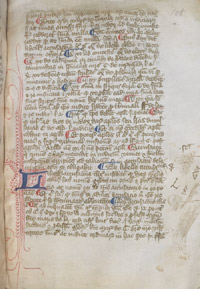 |
 |
 |
 |
 |
 |
 |
|
The new foundation (4/9) Progress was slow. It was some thirty years before the Cistercians had a new site and a willing founder - Chichele, archbishop of Canterbury, a graduate of New College, Oxford, and founder of All Soul’s. In 1437 St Bernard’s College was officially founded on the spot where St John’s College, Oxford, now stands.(14) It is interesting to note that prior to its official foundation, Cistercian scholars regarded themselves as the college of St Bernard’s: John Blonton of Jervaulx is described in 1433 as provisor of St Bernard’s; a progress report on three monks – including a William Bryent of Fountains – recommends that they should remain at St Bernard’s, at the expense of their own community, to complete their doctorates in theology.(15) St Bernard’s was dedicated to the Virgin Mary, the patron of the Order, as well as to St Bernard. The first provisor of the college was William Bramley, who was probably a monk of Fountains Abbey.(16) Whereas Rewley had simply followed the statutes drawn up for the Cistercian college in Paris, statutes were compiled specifically for St Bernard’s, Oxford, following visitation of the studium by the abbot of Morimond in 1446.(17) These twenty-one clauses regulated various aspects of the scholar’s life and the daily administration of the college. For example, all scholars were to eat together while a reading was given; they were to say grace before and after the meal and observe silent until the benediction had been given. Any scholar of St Bernard’s who wandered around the town at night, faced excommunication. Anyone who brought seculars into the college without permission, or smuggled women into the college or rooms, was punished.(18) This fresh beginning brought little change and, like Rewley before it, St Bernard’s met with a rather lukewarm response. Efforts were made to boost numbers. In 1480, every abbey in England was to send one monk to study at the studium for every twelve in the community; those with only a few monks were not exempt, but were to join together to find a candidate. In 1483 the king urged all abbots to make a contribution to the college, in addition to money they had given for building work.(19) These measures had little impact; St Bernard’s lacked resources, students, buildings and, fundamentally, enthusiasm. An order as large and wealthy as the Cistercians should have had little difficulty building and maintaining a college for a handful of scholars, but money allocated to the studium had been channelled other directions; by the mid-fifteenth century there were complaints that the abbot of Vaudey had misappropriated the college funds.(20) The provisor and students of St Bernard’s complained that their college was a disgrace to the Order.(21) The buildings were in a ruinous state and the Cistercian studium was quite literally the talk of the town.(22) At the end of the fourteenth century, Abbot John Darnton of Fountains wrote to inform the abbot of Cîteaux that not even a third of the buildings had been finished; he maintained that if all the money assigned to building work been used faithfully for this purpose, the Cistercians would now have a worthy building that was a source of pride, rather than shame.(23) |
||
|
